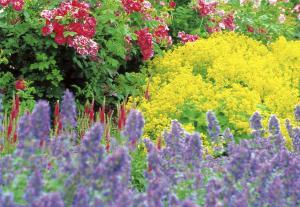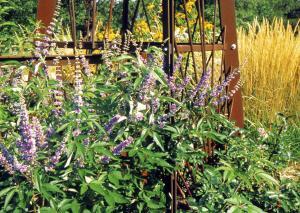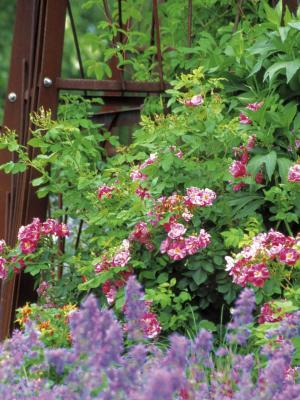By Theresa M. Forte
 | |
| Visitors parking at the Niagara Parks Commission Gardens are greeted with plants designed for both long-range and close-up curb appeal. |
This philosophy also extends to public spaces and larger industrial properties. Where business would like to project a positive (often green) image, a naturalized garden, in keeping with the scale of the property, will often replace the traditional manicured lawn and geometric foundation plantings. When the site is primarily industrial, beautiful gardens do much to soften harsh walls of concrete, steel and glass and acres of asphalt paving.
A functional parking lot does not evoke dreamy thoughts of meadow-like gardens. And yet, large scale naturalized island plantings in the spirit of Wolfgang Oehme and James van Sweden (famous for their North American prairie style) lend themselves to these applications. Unforgiving, sterile acreages are transformed into places of vibrant natural beauty. By reclaiming these open spaces, we make them welcoming habitats for wildlife and relaxing, healing places for a walk at lunch or to sit on a bench and appreciate the changing seasons.
To illustrate the effectiveness of softening a parking lot and creating a welcoming public persona by means of gardens, let's examine the recently redesigned entrance gardens to the Niagara Parks Commission Botanical Gardens (NPCBG) and School of Horticulture located in Niagara Falls, Ont.
Ruedi Hofer of P.M.A. Landscape Architects was the landscape architect responsible for the overall design of the entrance garden. Tom Laviolette, superintendent of the NPCBG and Butterfly Conservatory, and Lorne Fast, horticultural taxonomist and instructor, worked closely with the landscape architect to fine-tune the plant selections.
|
In their book, Bold Romantic Gardens, Oehme and van Sweden describe their technique for designing large, public gardens: Structural elements are the first consideration, retaining walls, berms, obelisks, trees and large shrubs. These elements work together to "Establish a framework of canopy and edges," according to van Sweden. "They will screen views, subdivide the space, provide focal points and determine the rhythm of the garden. Trees create pockets of shade, add winter structure when the garden is bare and add year-round interest in terms of texture, bloom, fruit and bark." The NPCBG entrance garden includes rows of native red oak (Quercus rubra), planted on either side of the parkway, and a series of distinctive iron towers planted with a variety of climbers for structure. As the oaks mature, they will create a canopy over the roadway. The parkway follows the natural curve of the Niagara gorge, and the gardens echo this graceful shape. A metre-high limestone retaining wall divides the parking area from the garden; the space behind the wall was backfilled to create a raised bed. Beyond the garden, a narrow band of turf separates the garden from the busy thoroughfare, offering safe access to the beds for maintenance, and a buffer zone in winter when snowploughs clear the road. The raised beds are filled with masses of vibrant perennials, roses and ornamental grasses that give a sense of majesty and importance to the space. Oehme and van Sweden suggest that herbaceous perennials add a dynamic quality to their plans, and account for 60 to 80 per cent of the materials used in their designs. Life cycles of the perennials evolve over the seasons, from emerging buds, through blooming and on to dried seed pods. Goundcovers make up the final layer and are described as low, broad masses interconnected by over-weaving groups of taller, sculptural plants. Perennials act as indicators of time in the garden, evolving and ever dynamic as the seasons advance. Let's look at a small selection of the perennials included in the NPCBG entrance garden. Early summer interest is achieved with masses of Eryngium planum 'Sapphire Blue' (sea holly), Rosa x Kordesii 'William Baffin', Nepeta 'Dropmore', Hosta sieboldiana 'Elegans', Alchemilla mollis (lady's mantle), Veronica spicata 'Red Fox', Echinacea purpurea 'Magnus' and Calamagrostis x acutiflora 'Karl Foerster'. By early September, many of the summer perennial stars begin to age gracefully, while fall blooming Aster novi-belgii 'Professor Anton Keppenberg', Rudbeckia fulgida 'Goldsturm', Eupatorium purpureum 'Gateway' and Vitex agnus castus (chaste tree) are in glorious bloom. This public garden is on constant display as visitors drive, cycle or walk along the Niagara Parkway, and has been designed to attract and hold the attention of passers-by. It may even slow them down and create a safer roadway in the process. The planting creates a grand welcome for guests and inspires a sense of pleasant anticipation, how many horticultural treasures lie within the botanical garden, yet to be explored? Parking lot gardens have a set of unique challenges, according to Fast. The soil in this particular site was worked to depth of 24 in. (60 cm), necessary because the existing soil was extremely compacted. The plant materials are disease resistant, heat tolerant, and should be able to withstand snow and salt as much as possible. Underground sprinklers were installed for irrigation. Limited staffing for maintenance is another consideration, line trimmers fitted with hedge blades are used to cut back perennial grasses in the spring. The clippings are left to mulch the beds and seem to disappear as fresh growth fills the beds, according to Fast. They try to keep one step ahead of weeds by removing them early. Some plants such as Echinacea and Rudbeckia fulgida are allowed to self-seed and can be edited as required. The garden employs a more varied palette of plants than the beds designed by Oehme and van Sweden, but they share the same philosophy, says Fast. Liz Klose, superintendent of the School of Horticulture, suggests the garden provides "a signature landscape" for the school, highlights the knowledge and work ethic of its students and shows what you can do when planting en masse. Klose continues, "The large masses of plants are proportionate to the large scale of the parking and entrance space." Just as the gracious front garden proved a successful 'business card' for the bed and breakfast, a parking lot transformed into a garden creates a vibrant sampling of the talent the school has to offer. Parking lot gardens reflect a dynamic corporate image, where a relationship with nature is valued. Theresa M. Forte is freelance garden consultant, writer and photographer based in Niagara Falls, Ont. Images courtesy Theresa M. Forte |


